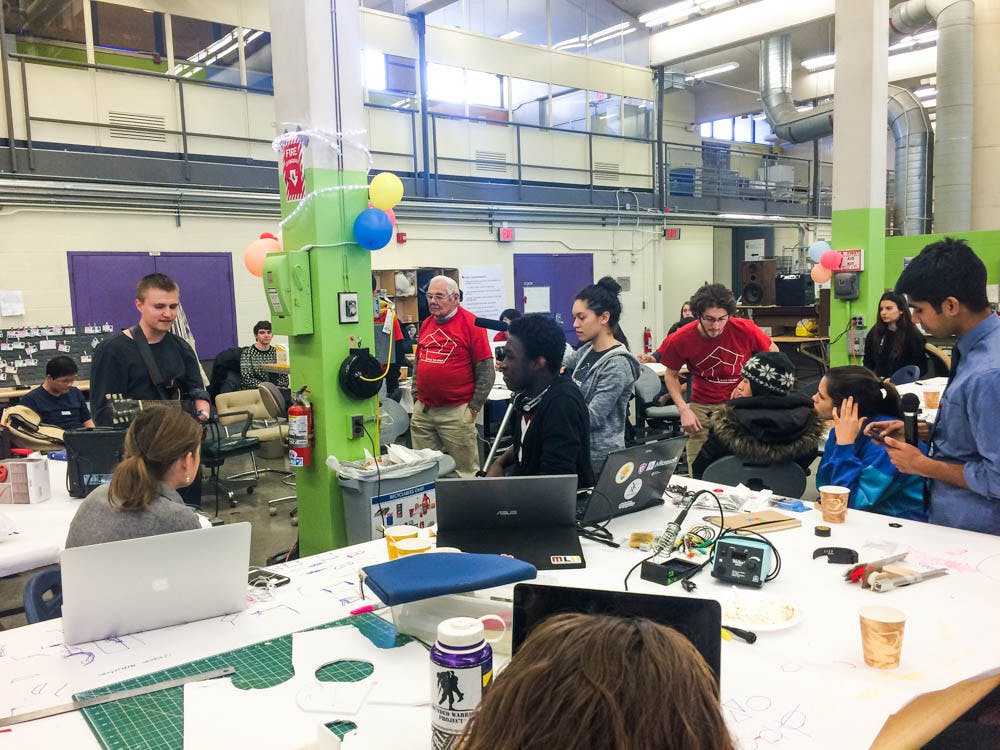Amid the bustle of 3D printers and laser cutters, students bent over in concentration, working on prosthetics, tinkering with wires and experimenting with technology they hoped would change lives. The Brown science, technology, engineering, arts and math community hosted an assistive technology makeathon over the weekend, bringing together an eclectic mix of students, volunteers and mentors to find solutions aiding those with disabilities. Held in the Brown Design Workshop, the students worked to re-invent traditional technologies.
Unlike traditional hackathons and competitions, the makeathon aimed for a more intimate feel to foster collaboration through its size. “Smaller environments allow more collaboration,” said Maggie Mathieu ’17, who organized the event. Collaboration “eventually (helps) the designer empathize with the users,” she added, which — along with understanding each individual’s needs — was one of the primary focuses of the weekend.
Students were led through exercises even before starting their projects, taking on tasks such as opening bottles with one hand and walking while wearing foggy glasses. The goal of the exercises was to align the viewpoints of the participants with those who needed assistance, said Ciaran Godfrey ’19. Godfrey’s favorite exercise involved trying to hear numbers being called out amid a louder conversation, which served as a simulation for those with hearing and concentration issues.
After becoming accustomed to these needs, the participants were divided into groups to brainstorm and begin projects. Whiteboards with topics such as interaction, mobility, hearing and vision quickly became filled with ideas and drawings. One idea that quickly emerged was different ways for a phone to respond to the simple concept of asking it, “I’m blind. Can you help?”
Some participants worked directly with people who need the assistive technology. Carl Romines ’17, a music and physics concentrator, came looking for a better prosthetic to play his guitar. He previously created equipment himself, but it quickly fell apart, he said. A group consisting of Brown students, Rhode Island School of Design industrial design majors and event organizers worked with him to design a sturdier and more comfortable guitar pick holder. Within an afternoon, the team went from string and paperclip prototypes to sewing foam together, troubleshooting with Romines, who brought his own guitar in to play.
“I love my team because I would say what I needed, and then they would help me with materials like elastics,” he said.
Another project presented at the final review Sunday included an infrared sensor made by Godfrey. The sensor was intended to attach to the hands of those visually impaired and to buzz when in close proximity to objects, providing another sense for the blind, Godfrey said.
Throughout the makeathon, the organizers emphasized learning new techniques and experimentation, holding workshops to familiarize the participants with the many sources of equipment in the Design Workshop. John Filmanowicz ’17 was both an organizer and a worker in the Design Workshop, providing support for the variety of 3D printers available to participants. Filmanowicz emphasized the availability of the tools in the Brown community. “It’s incredibly easy to register and train for these types of tools,” he said, adding that the entire process takes less than 20 minutes.
The event attracted a much more diverse group than simply Brown students. Along with a variety of RISD students and one visitor from Harvard, multiple engineering professors visited the event, gave commentary and participated as mentors. Projects were judged by a panel composed of alums and faculty members, including Professor Emeritus of Engineering Barrett Hazeltine.
At the end of the weekend, five groups presented their inventions to the panel and an eager audience. Several people asked questions about comfort and safety regarding each piece of assistive technology, with PowerPoint presentations leading to hands-on discussions and vivid roundtables.
Romines’ group drew rapt attention with its final project, which concluded with a guitar solo from Romines, now aided with an improved prosthetic pick and wristband.
“I had to be really tense with past prosthetics, and I couldn’t find any way around that,” he said. With his new technology, Romines can now play with much more precision and technique, according to his group.
“It’s a really important process, understanding how mechanisms work, … but for people like (Romines) — people who use this technology — they are the best experts of knowing what they need and what they want,” said participant and organizer Jeremy Joachim ’17.





